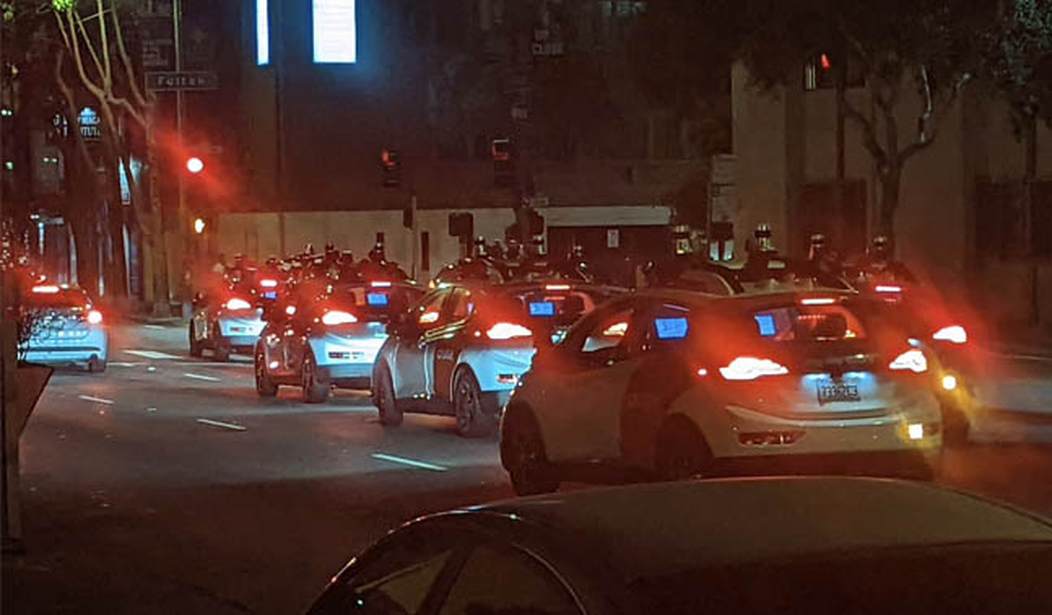San Francisco has been allowing tests of driverless cars and taxis and according to this report in Salon, the cars have occasionally been making a mess out of traffic:
On Sept. 30 at around 11 p.m., an N Line streetcar ground to a halt at the intersection of Carl Street and Cole Street because an autonomous vehicle from Cruise, a subsidiary of General Motors, had halted on the streetcar tracks and wouldn’t budge. According to the city’s transportation department, the 140 passengers riding the N line that evening were stuck in place for seven minutes before a Cruise employee arrived and moved the driverless conveyance. (Cruise did not respond to questions about what happened that night.)
This incident, which was not reported in the media at the time, is one of many in which autonomous vehicles roaming San Francisco’s streets have disrupted the city’s transportation network. In April, a Cruise vehicle blocked a travel lane needed by a siren-blaring fire engine, delaying its arrival at a three-alarm fire. Last fall, dozens of self-driving cars from Google’s Waymo subsidiary drove daily into a quiet cul-de-sac before turning around, much to the frustration of nearby residents.
Developers of autonomous vehicles have to report any “disengagements” (moments when the software gives up and cedes control to a human driver) to state regulators. However, there’s a catch. In California, autonomous vehicles don’t have to report problems if they are accepting fares.
Strange as it may seem, California stops requiring that AV companies share disengagement data and collision locations as soon as they begin collecting passenger fares, as Waymo and Cruise now do. From that point forward, if an AV vehicle jeopardizes safety on the street—for instance, by causing a crash or blocking a transit line—the public won’t know unless the AV company chooses to publicize it (unlikely) or if a passerby reports the incident to 911 or posts about it on social media (unreliable).
So because of the way this is set up, no one really knows how often stuff like this happens:
Called the first responder # displayed on the screens in the car. @Cruise had a team out there in about 20min. @EllaSogomonian pic.twitter.com/Ot6vyBqxQo
— Dan Thorn (@DanThorn_) September 23, 2022
Back in April a police officer tried to pull over a Cruise car and after he got out and realized there was no one inside the car drove away.
Cruise driverless car gets pulled over in San Francisco, tries to run for it! @elonmusk pic.twitter.com/64MTbJ7rm0
— Whole Mars Catalog (@WholeMarsBlog) April 10, 2022
In June a group of six or more cars seemed to all become stuck together on one street.
Some @Cruise robotaxis appeared to be stuck in SF last night at the corner of Gough St. and Fulton St.
Human ops apparently had to rescue them. Still some kinks to iron out. pic.twitter.com/eXDocjVfHU
— Taylor Ogan (@TaylorOgan) June 30, 2022
Something similar happened last month:
This is precious. @GM autonomous robotaxi subsidiary @Cruise singlehandedly causing gridlock in San Francisco. #SelfDrivingCars @WholeMarsBlog @28delayslater pic.twitter.com/htCwRyubhH
— Gary Mark⚡️Blue Sky Kites (@blueskykites) November 30, 2022
It’s not just Cruise, Waymo has also made the news for some weird driving habits:
San Francisco transportation authorities sent a letter to the NHTSA in September recommending some changes:
The letter highlighted Cruise’s patchy response to emergencies: “On one occasion on August 4, 2022, a City dispatcher placed four calls over six minutes [to Cruise’s emergency response line]; none of these calls were picked up.”…
In their letter to NHTSA, San Francisco officials proposed several ways to improve AV oversight. They suggested that NHTSA treat “travel lane failures that block roadways” as a key measure of AV readiness, adding that NHTSA should also quantify and publicize AV companies’ response times to vehicle emergencies.
But if you check the Twitter account for Cruise, they are nothing but bullish about the company’s future in San Francisco.
Speaking of AI breakthroughs, this is what scaling fully driverless cars—all powered by crazy cool ML—looks like.
We now regularly deploy 100+ fully driverless @Cruise cars (no driver, just passengers) concurrently on the streets of San Francisco, scaling faster every day. pic.twitter.com/i8YNAPEMeF
— Oliver Cameron (@olivercameron) December 2, 2022
Personally, I’m pretty bullish on driverless cars. It does seem inevitable that this will become the norm, maybe within a few more years. But while things are still in the testing phase it would be nice if companies could keep their occasionally confused vehicles out of the way of other drivers.
Finally, it’s worth noting there seems to be some of this happening as well:
This is a pretty exaggerated attempt to get our AV to "mess up".
The driverless @Cruise AV (named Kumquat) shifted to the left to give extra space even before this reckless person darted in front of it. pic.twitter.com/QMsYDOPwZT
— Kyle Vogt (@kvogt) November 22, 2022
For some (I’m guessing mostly young and male) city residents, driverless cars are just something for them to mess with:
This driverless @cruise AV (named Chorizo) was tracking both the person and their dog and managed to swerve to avoid a collision.
Risking your life to prank an AV is stupid, but it's your call. Just leave your dog out of it. pic.twitter.com/HxjQ4xfMOv
— Kyle Vogt (@kvogt) November 14, 2022







Join the conversation as a VIP Member